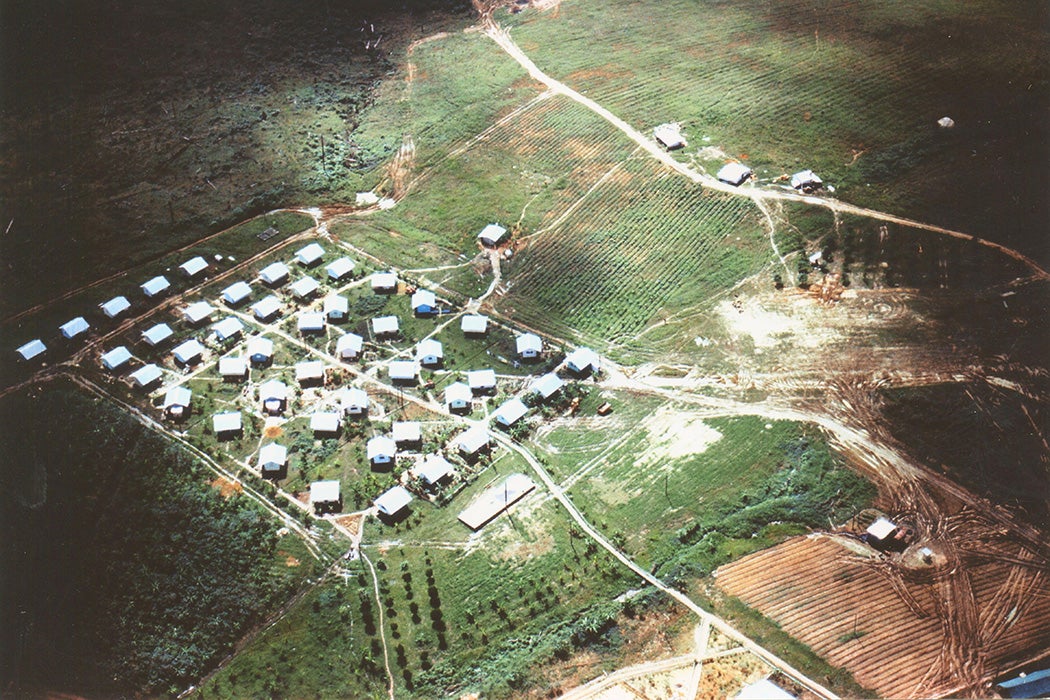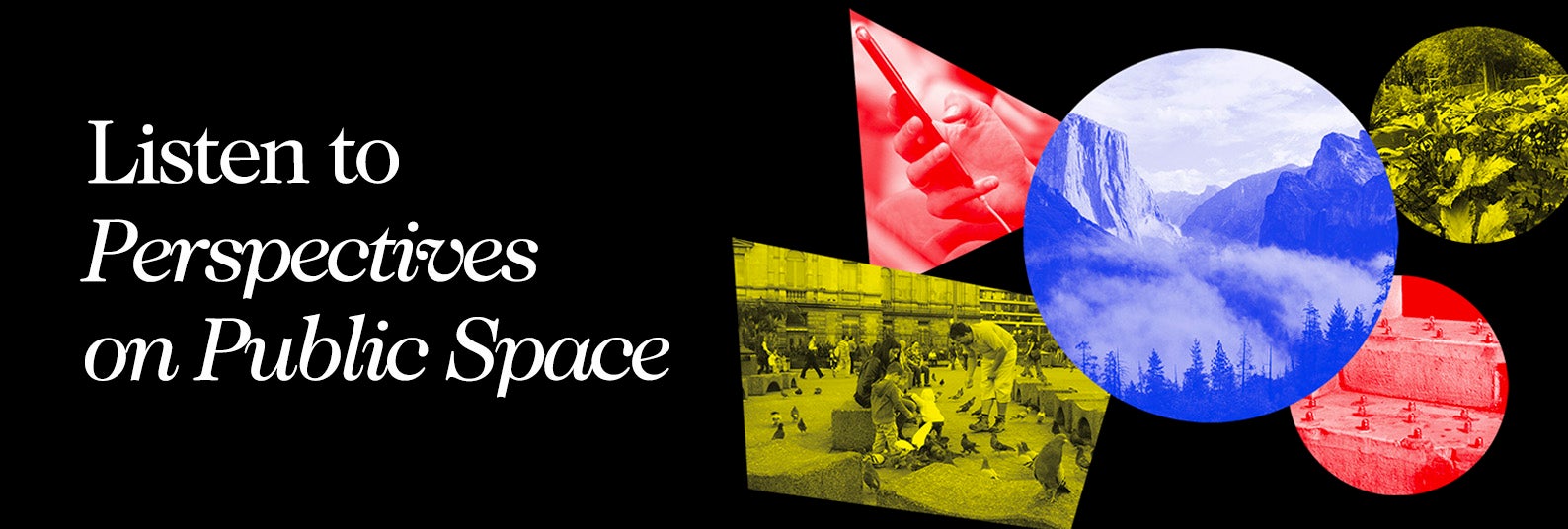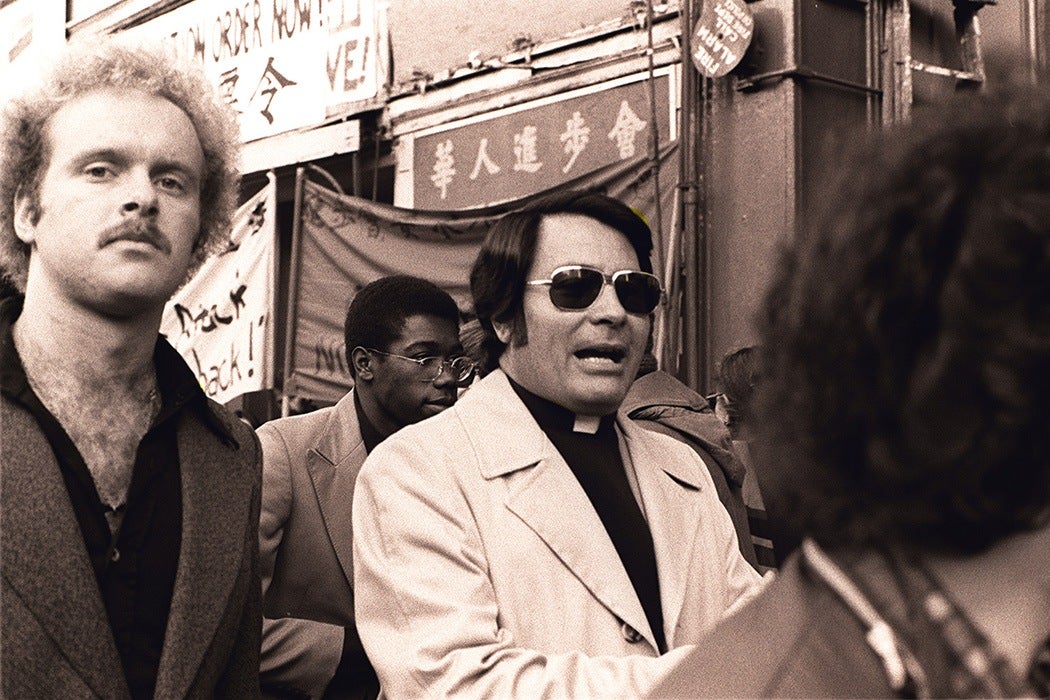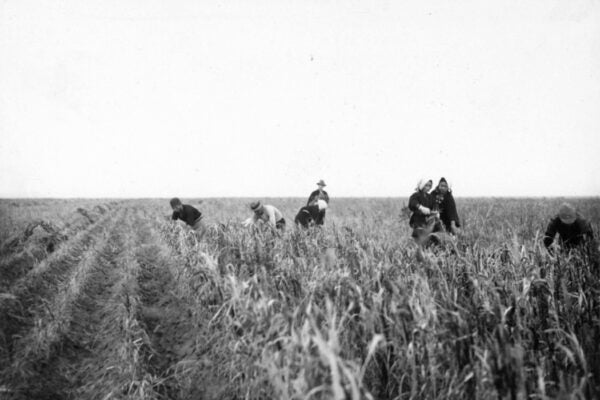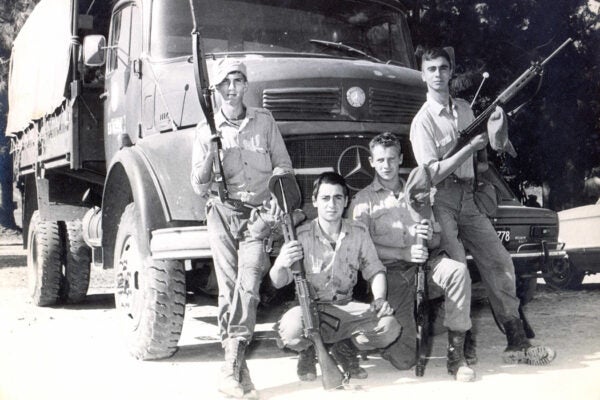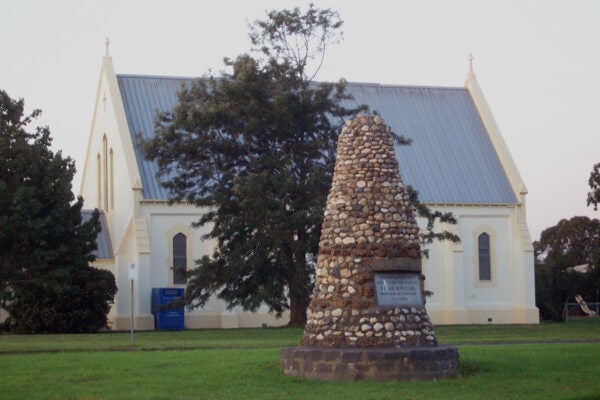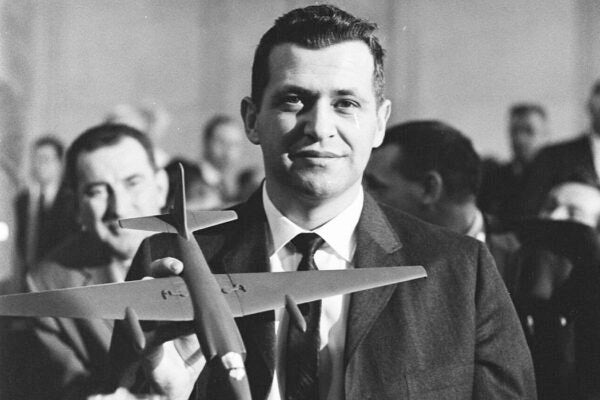In late 1975, members of a cult called the Peoples Temple, seeking a life in their “Promised Land,” began carving out a town from the Guyanese jungle. They named this growing Eden “Jonestown” to honor their leader, Jim Jones, and intended it, as journalist Mark Powelson wrote in the Berkeley Barb in late 1978, to be “a place to build a true socialist society. Free from harassment, racism, and the constraints of capitalism.”
In some ways, their dream came true: Jonestown was a place, as one resident put it, “where we can eat, work together, share our achievements and enjoy common entertainment.” And it thrived as a kind of agricultural utopia, at least temporarily. Then, on November 18, 1978, more than 900 members of the cult, the cult’s leader, members of the media, and a United States Congressman died, most from cyanide poisoning and some from gunshot wounds (self-inflicted and otherwise). Gone with their deaths were their individual stories—tales of personal triumphs and disappointments.
The story you’re reading now is one of those: a story of tragedy, resilience, and community as seen through the life and death of Minnie Murral. Murral migrated to the Peoples Temple. She lived and died in Jonestown, and her story is inextricably intertwined with the history of Black America. Though she was married, she was using her maiden name, Murral, at the time of her death. It was the name upon which she built her life.
Murral’s life began in Forest, a small, impoverished town in Mississippi aptly named; there were, and still are, more trees than people there. With a population today of only about 5,500, the town boasted even fewer residents—around 2,500—in 1941, the year Murral in which was born. Forest is one of the few areas in the state with a minority-majority, meaning then, as now, the majority of residents were impoverished and Black, the children and grandchildren of enslaved people and sharecroppers. This was true across many small towns in the South. The people of Forest rented their land from white, wealthier landowners. In exchange for a tiny house and a portion of the crop, Black farmers provided labor, fertilizer, and tools according to historian Louis Ferleger, who notes that Black sharecroppers “had very little decision-making power over farming practices.”
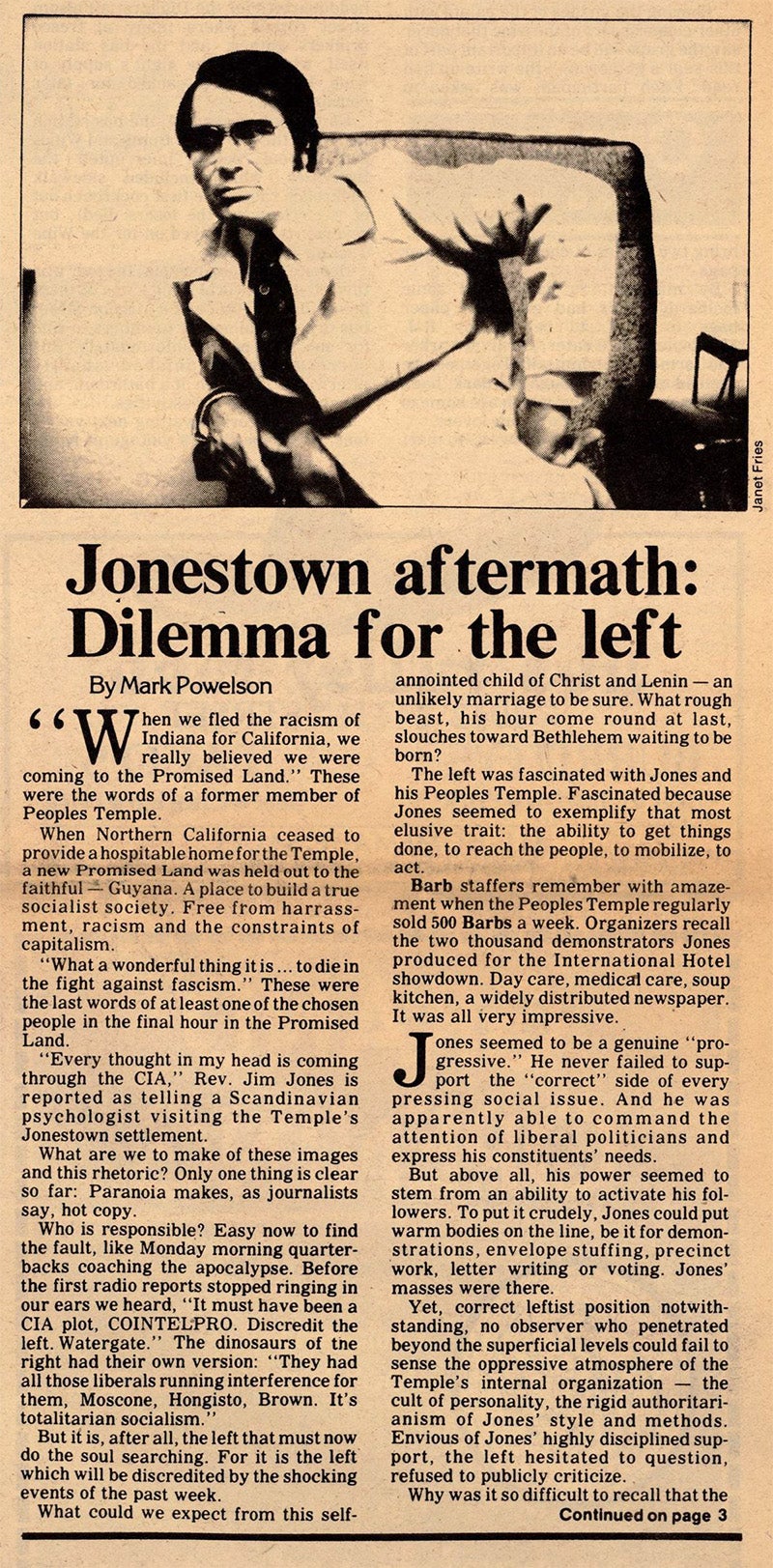
Murral’s parents and grandparents were sharecroppers and neighbors, each working on different plots of land near the house in which Murral and her six siblings grew up. Undoubtedly, the family had to learn to make a little go a long way. The kids likely worked the land just as hard and as often as their parents, earning bruises and calluses for their trouble, but willing to contribute to make the daily toil just a little bit easier for everyone. Surviving members of the Peoples Temple shared stories with the author of this story about Murral and her siblings making their own clothes, canning their own food, and traveling to wealthier neighborhoods nearby to sell the little they could spare. It seems this was the nature of Murral’s life until the mid-1950s, when she married and moved to another small town called Walnut Grove.
Her husband, Reverend Cassie Buckley, was a Baptist preacher who believed in procreation for the Lord, creating more “arrows of God,” per the directive from Psalms. Herself a Christian, Murral was happy to follow the Lord’s plan.
First, she gave birth to four daughters: Lorthea in 1957, Dorothy in 1961, Odessa in 1962, and Frances in 1964. Two years later, she birthed twin boys, Christopher and Curtis. No one seems to know when her husband started to abuse her, but it’s believed among Temple survivors that it started soon into the marriage. Buckley would “correct her” according to family and friends, never “sparing the rod” so that she could better become a “proper wife.” Minnie endured the abuse for years, and the violence left permanent marks: scars on her body and a glass eye.
For a moment, put yourself in her shoes. Feel her pain, her fear, and her sense of being stuck. Leaving Buckley would be a challenge. Divorce was uncommon in that era and region, and it was forbidden by the church, which constituted Murral’s community. She was, moreover, married to a well-respected religious leader. She endured for the sake of her children, not only in the hope of keeping them together but also to deter Buckley from turning on them. Her efforts were for naught; in late 1967, Buckley trained his violence on Lorthea. That act was the last straw. In the middle of the night, Murral took her children and fled, following in the footsteps of other southern Black Families in the Great Migration. They headed west to California.
The Great Migration is often considered one large push North by poor Black southern farmers. Contemporary research tells a different story. In fact, along with sharecroppers seeking new opportunities, many Black city-dwellers likewise moved north and west to escape Jim Crow.
Weekly Newsletter
“As the great Migration proceeded,” observed sociologist Stewart Tolnay in his examination of the exodus, “the South suffered substantial losses of its native-born Black population, with over 2.5 million southern-born Blacks living outside of the region by 1950 and over 4 million by 1980.” Murral and her children were just one family among millions to flee, though they were chasing the same dream: happiness, equal opportunities, and a new start.
Murral arrived safely in Los Angeles, but her struggle remained. According to the Center for Relationship Abuse Awareness, the most dangerous time for survivors of domestic violence is right after they leave their abusers, who often come looking for them. And Murral hadn’t run alone from her husband, she took their kids.
From the days of enslavement, there are stories of Black women forming a safety net of people around them to help protect themselves, their friends, and their children. Even the earliest enslaved women to reach the “new world” in 1619 quickly formed a community.
“Most of those who arrived,” writes historian Brenda Stevenson, “came from the same region of Angola, spoke the same language and shared other cultural attributes, it is not surprising that there remains evidence of community life.”
This phenomenon is prevalent in stories of Fannie Berry, a freed woman known for her tales about the days of enslavement.
“The black female presence—physical, psychological, social, moral, and cultural—dominated the worldview, intellect, and imagination,” Stevenson continues, helping her “create a utopian view of her enslaved female community and the culture they shared that she purposefully passed on to the later freed generations through her storytelling.”
Community was quite literally passed down generationally to ensure not just continued survival but the continued thriving of generations of Black women. While a community is easiest to form with like-minded individuals, they are not the only people who can form one. As Stevenson puts it, any group that “acted as individuals, but their actions reverberated through the community for the good of the community” helped people flourish.
That’s what Murral needed in Los Angeles: the safety and reliance of a network to help ease her burdens. She found it in the Peoples Temple and, later, Jonestown. Founded by Reverend Jim Jones, a white preacher, in Indianapolis in 1954, the Peoples Temple was built on principles of equality and helping others. As institutions throughout the rest of the country operated under segregation, the Peoples Temple welcomed everyone to mix together. This appealed to civil rights activists in Indianapolis, many of whom joined up. In Indiana, as it later did in California where it relocated in 1965, the Peoples Temple ran food banks, helped prepare “cold day” packs to help people survive when temperatures fell, and opened its doors to the sick and needy.
Before the Temple moved West, it instituted “religious communalism;” members donated their possessions and money so the Temple could help yet others. In California, where Jones fully embraced a philosophy that encompassed communal living, anti-capitalism, and anti-racism.
“Man, the only sin you’re born in, is the society, the kind of community you live in,” he preached in 1973. “If you’re born in a socialist community, then you’re not born in sin. If you’re born in this church, this socialist revolution, you’re not born in sin. If you’re born in capitalist America, racist America, fascist America, then you’re born in sin.”
Jones opened a communal living space in Redwood Valley, along with other shared houses across the state to facilitate members’ service attendance. While press about the Peoples Temple had started out positively, it turned once reporters got wind of the church’s darker side. Stories emerged detailing abuses. A 1977 expose in a San Francisco paper told of Linda Mertle, who’d left the Temple after a savage beating and asserted that “church leaders staged phony cancer cures, lied to the congregation about contributions collected at services, routinely paddled members for minor infractions and pressured members to turn over their property, money and homes to the church.” All of these allegations later proved true.
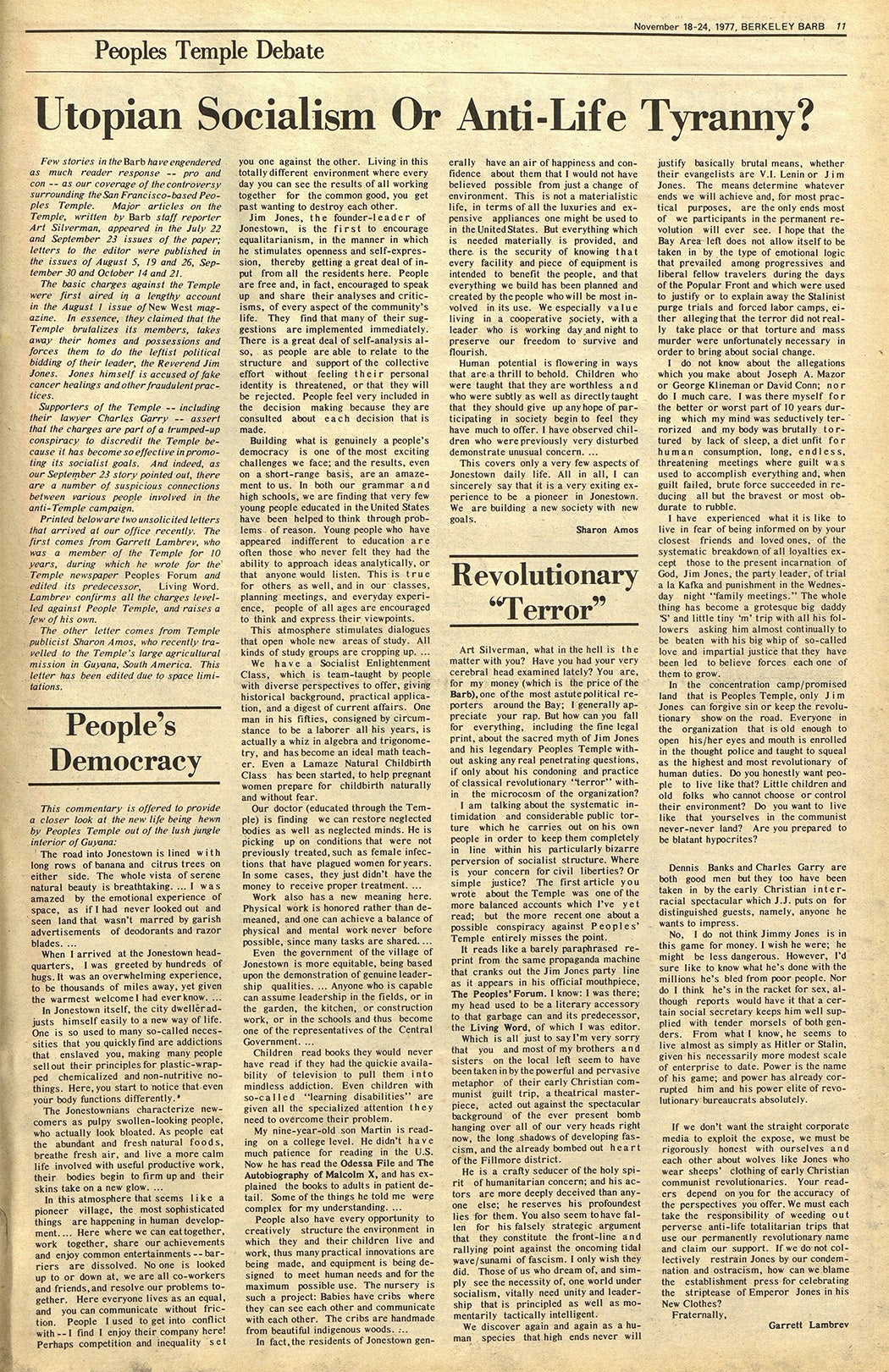
In the wake of such revelations, Jones needed to free his Temple from the threat of government interference and alighted upon Guyana as a new home. The congregation moved to the small jungle town and, by congregational vote, christened their new encampment “Jonestown.” In a November 1977, the Berkeley Barb published an account by Sharon Amos—who died in the massacre—of her arrival at Jonestown,
“I was greeted by hundreds of hugs,” she reported. “It was an overwhelming experience, to be thousands of miles away, yet given the warmest welcome I had ever known.”
There’s a common assumption about members of Peoples Temple that they’re crazy or undiscerning cult followers, but the truth is more complicated. Finding in the Temple a family of friends made its members want to stay.
Over the course of five years of research into Jonestown, the author has discovered countless examples of widowed or divorced Black women who found safety and comfort within the Temple and among fellow congregants. In fact, more than 50 percent of the single members of Jonestown were divorced or widowed Black women. For her part, Murral was a girl from a small town in a bustling new city. How could she know where to start rebuilding her life?
The Temple and its structure saved Murral. It helped her feed and clothe her children. It had a team of lawyers on staff to help her file for divorce. Indeed, hers was finalized in January 1969. Though the composition of communal living groups changed often, it always included people willing to play with or babysit Murral’s kids. There was even a public school, Opportunity High, that many of the Temple children attended.
This story doesn’t have a happy beginning or ending. But it has an inspiring middle. Murral, against all odds, rebuilt her life, carving out a place for herself and her children. She forewent Minnie for Luna, her middle name, to mark this new chapter, and took up work nursing the Temple’s elders and children. She was beloved by fellow church goers and is said to have exuded a unique, gentle, and caring maternal aura; both she and her kids were well-mannered and kind. They moved to Jonestown in August 1977 and lived in Cottage 3, one of more than sixty houses spread out on nearly 4,000 acres. There were gardens, crop fields, a school, even a hospital complex. At the center of the site was a pavilion where Temple members assembled in the middle of the night at Jones’s request. It’s also where members lined up at gunpoint and drank cyanide-laced Flavor Aid, taking part in a “revolutionary suicide.”
More to Explore
Drinking the Kool-Aid at Jonestown
Why would Murral, so strong and brave, take her own life? Having endured so much, why did she decide to end it all in Jonestown?
According to Sharon Amos, Jonestown residents “have an air of happiness and confidence about them,” which she attributed to the few months they lived communally in Guyana. The Peoples Temple succeeded, at least for a few years, in creating a place where co-workers, friends, couples, and singles, old and young worked toward a shared goal of demonstrating that there might be a better way to live together. They built a family. Survivor Kathy Tropp explained to the author that “[w]e were not there for Jim Jones, or the revolution. We were there for each other. We were one living and breathing organism, caring for each other.” Murral died for the family she made within the Temple, whose community saved her when she was in the direst of straits.
Murral’s story, and others like it out of Jonestown, remind us of a fundamental truth: people need one another. Minnie Murral needed help to get by and found it, though she did so in a community that en masse made a tragic decision. Still, many of the people of Jonestown were motivated by hope and a desire to build something meaningful.
Annie Moore died at Jonestown; she drafted a letter as everyone lined up to take a last drink.
“What a beautiful place this was,” she wrote. In her estimation,
[t]he children loved the jungle and learned about animals and plants. There were no cars to run over them; no child-molesters to molest them; nobody to hurt them. They were the freest, most intelligent children I had ever known. Seniors had dignity. They had whatever they wanted—a plot of land for a garden. Seniors were treated with respect—something they never had in the United States. A rare few were sick, and when they were, they were given the best medical care. We died because you would not let us live in peace!
Editor’s Note: This story was amended to correct a typographical error in the twenty-first paragraph.
